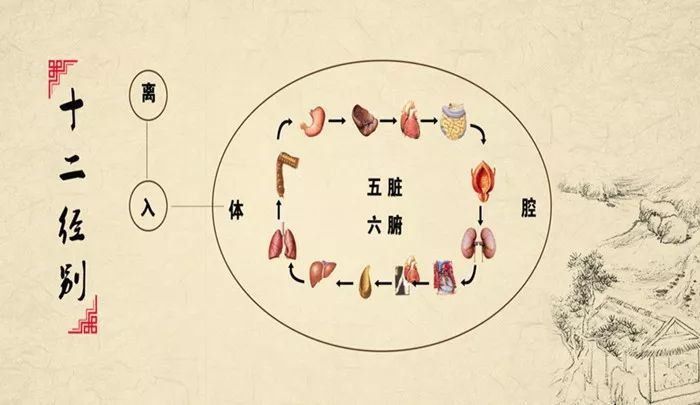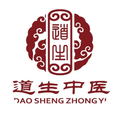▲Click the blue “Dao Sheng Academy” above to follow us
“Pin to the top of the public account,” take some time to fall in love with Traditional Chinese Medicine (TCM)

Exterior and Interior Meridians
The twelve meridians are paired as six exterior-interior meridian pairs according to the matching of the hand Taiyin (Lung) with hand Yangming (Large Intestine), foot Taiyin (Spleen) with foot Yangming (Stomach), hand Shaoyin (Heart) with hand Taiyang (Small Intestine), foot Shaoyin (Kidney) with foot Taiyang (Bladder), hand Jueyin (Pericardium) with hand Shaoyang (San Jiao), and foot Jueyin (Liver) with foot Shaoyang (Gallbladder). The exterior-interior meridians are anatomically adjacent to each other, connected through collaterals, and have a special relationship in the transformation, complementarity, and balance of Yin and Yang, thus exhibiting a complementary and synergistic effect on Qi transformation. Therefore, based on the relevant discussions in the Neijing and Nanjing, combined with modern anatomical and physiological connections, a deeper discussion of the pathways of the six pairs of exterior-interior meridians is conducted, which is of significant reference value for modern TCM scholars to better understand classical theories.

Anatomical Basis of the Exterior-Interior Meridian Relationship
The exterior-interior relationship is a very important connection pathway between the twelve meridians, and the twelve organs associated with the twelve meridians also have corresponding exterior-interior relationships. Among the six pairs of exterior-interior relationships, according to modern medical understanding, it is easy to find that four pairs, namely Spleen and Stomach, Liver and Gallbladder, Kidney and Bladder, Pericardium and San Jiao, have obvious anatomical proximity, as well as similar blood supply and nerve innervation pathways. The physiological and pathological correlations arising from this are easily understood. Since the Yin and Yang meridians with exterior-interior relationships and their corresponding organs share the same Qi and blood pathways, with the same nutritional sources and metabolic pathways, this forms the characteristic of mutual connection in physiological functions, mutual influence in pathological conditions, and mutual supplementation in treatment between the exterior-interior meridians and organs.
However, the anatomical and physiological relationship between the Lung and Large Intestine, and the Heart and Small Intestine is not as obvious. How can we understand the connection pathways of these two pairs of exterior-interior relationships?
Those familiar with the classics know this is an ancient proposition. As early as the time of the Nanjing, ancient physicians raised the question: “Each of the five organs has its corresponding fu (viscera), all are close, yet the Heart and Lung are far from the Large and Small Intestines, what does this mean?” The answer given was: “The classics say the Heart nourishes the Lung and circulates Yang Qi, hence it is located above; the Large Intestine and Small Intestine transmit Yin Qi downwards, hence they are located below; thus they are far apart.” However, this answer still seems unclear today, requiring further thought and explanation.
1Heart and Small Intestine
The Heart and Small Intestine have a close physiological relationship, mainly reflected in the production and circulation of blood. The Ling Shu states: “The pathway of Ying Qi is precious within the valley… thus Qi emerges from Taiyin, enters the hand Yangming and Taiyin, ascends to the Spleen, and from the Spleen enters the Heart.” Analyzing from the physiological function of “the Middle Jiao receiving Qi and transforming red into blood,” the function of the Spleen in TCM includes the digestive and absorption functions of the Small Intestine and pancreas, where bile and pancreatic juice enter the Small Intestine to further digest the chyme from the Stomach, and through the Spleen’s transformation and elevation, it is sent upwards to nourish the Heart and Lung, continuously supplementing and circulating Heart blood.
2Lung and Large Intestine
The exterior-interior connection between the Lung and Large Intestine is even harder to understand, as to why they are anatomically so far apart, yet have such a close exterior-interior relationship in terms of meridians? This involves two issues: First, TCM anatomy lacks the term esophagus; the Neijing only records the length of the distance from the upper opening of the Stomach to the throat, without mentioning the esophagus. Second, the Neijing refers to the Large Intestine as the broad intestine, describing it as a wide and large diameter digestive canal.
The digestive canal from the throat to the anus that fits the concept of broad intestine includes two segments; besides the Large Intestine, the esophagus is also relatively wide. Embryological studies have also found that the esophagus and Large Intestine share the same origin and structure. Therefore, it can be boldly inferred that the Large Intestine organ connected by the hand Yangming Large Intestine meridian includes both the esophagus and the Large Intestine. Literature and textbooks record that thirteen of the twenty acupuncture points of the hand Yangming Large Intestine meridian can treat symptoms such as difficulty swallowing, inability to eat, and vomiting after eating, indicating a close relationship between this meridian and the esophagus, which is also clinically proven.
From the perspective of modern anatomy, the trachea and esophagus are closely adjacent, and they share common arteries and veins for nutrient supply and waste excretion. This constitutes a very clear exterior-interior relationship. When the trachea is congested, the blood supply to the esophagus is relatively reduced. Similarly, when the blood supply to the trachea is low, the blood supply to the esophagus increases. In other words, improving the Qi and blood supply to the esophagus will affect the Qi and blood supply to the trachea, and improving the Qi and blood supply to the trachea can also influence the esophagus. Common clinical conditions such as esophagitis, esophageal reflux, and even esophageal cancer are often recorded in the literature related to the hand Yangming Large Intestine meridian.
(This article is excerpted from Mr. Wang Juyi’s Introduction to Meridian Medicine, please indicate the source when reprinting.)
▼Previous Highlights▼Meridian Lecture | Qi Transformation Characteristics of the Foot Taiyang Bladder Meridian Meridian Lecture | Qi Transformation Characteristics of the Foot Taiyin Spleen Meridian Meridian Lecture | Qi Transformation Characteristics of the Hand Shaoyin Heart Meridian ▼Related Recommendations▼

Click “Read the original text” to enter Dao Sheng’s selection and purchase Dao Sheng’s quality products!

